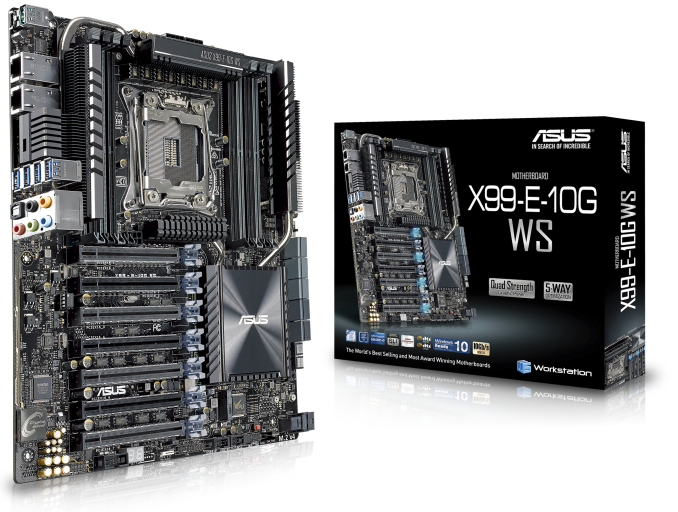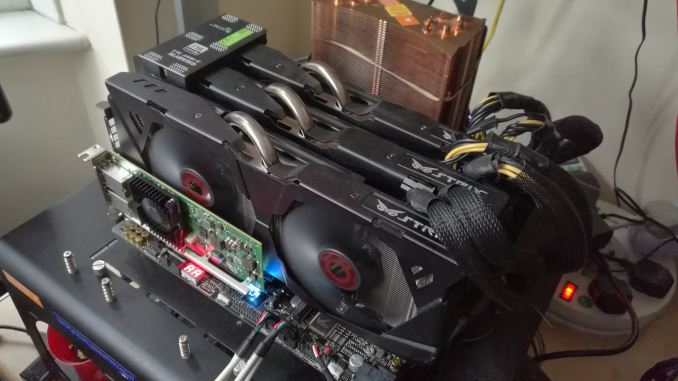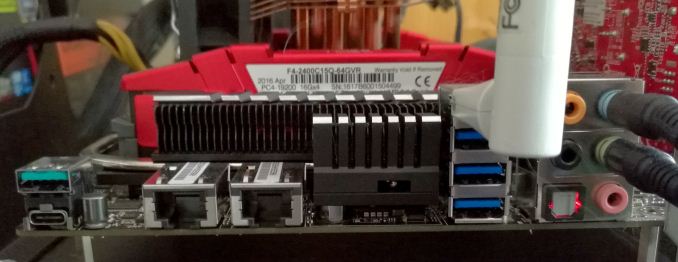The ASUS X99-E-10G WS Motherboard Review: 10GBase-T Networking with Intel’s X550-AT2
by Ian Cutress on November 7, 2016 9:00 AM EST- Posted in
- Motherboards
- Intel
- Asus
- 10G Ethernet
- X99
- 10GBase-T
- X99-E-10G WS
- X550
- X550-AT2
ASUS X99-E-10G WS Conclusion
As ASUS’ newest high-end desktop motherboard model, the X99-E-10G WS comes out with almost all guns blazing. It is hard to escape how much functionality is present, from a full complement of PCIe lanes (x16/x16/x16/x16) to dual 10G copper Ethernet ports to a full set of DRAM (and support for ECC Registered for Xeons) as well as PCIe storage for either M.2 or U.2 and USB 3.1 ports. Pretty much everything you need, except perhaps Thunderbolt 3, is here.
Ultimately this also pigeon holes the X99-E-10G WS into a highly specific market. Providing all this functionality isn’t cheap with the motherboard having to use two expensive Avago PCIe switches (PLX8747) and Intel’s newest PCIe 3.0 x4 X550-AT2 controller. This squares the motherboard down to users who needed 10G ports but were already lacking PCIe space. The numbers of users who qualify in that margin are set to be very low. Here’s an example of a use case: three GTX 980s with another 10G card (X540, PCIe 2.0 x8) attached in the bottom slot.
For performance, ASUS implements Multi-Core Turbo with the Core i7-5960X which gives our CPU benchmark results in the top half, but due to the PLX chip incurring a ~1% performance penalty, our gaming tests are the lowest we’ve seen for this set of tests on X99. For system benchmarks, the use of extra controllers does add to the POST time, but the audio performance is very good as well as USB 3.0/3.1 (with Turbo) and DPC Latency (one of ASUS’ recent strong points).
The BIOS and software side of the equation is ASUS’ usual consumer fare, and despite the X99-E-10G WS being a workstation focused board, aside from ECC Registered DRAM support with Xeons, there is nothing (nothing on the software side at least) that is specifically derived for workstations or prosumers that isn’t already on consumer platforms. That being said, fan controls, power and USB features are still relevant for most users.
The ASUS X99-E-10G WS does one thing really well – it offers the best single-socket option for integrated 10G support in the current market, and we will hopefully see more down the line (or at lower price points). As mentioned in our 10GBase-T motherboard overview earlier in the year, aside from the ASUS and ASRock boards available, and MSI’s C236 board with a single 10G port, options for integrated solutions are few and far between. Aside from switch pricing the ecosystem for home use, even as a prosumer play, needs to be driven by either switch availability (something like ASUS’ XG-U2008 at $250) or motherboard/PC adoption. So even at $600, the ASUS X99-E-10G WS shows how easy it can be to integrate 10G copper in the form of 10GBase-T.
Other Intel X99 Motherboard Reviews by AnandTech:
Prices Correct at time of each review
$750: The ASRock X99 WS-E 10G Review [link]
$600: The ASUS X99-E-10G WS Review (this review)
$600: The ASRock X99 Extreme11 Review [link]
$500: The ASUS Rampage V Extreme Review [link]
$400: The ASUS X99-Deluxe Review [link]
$340: The GIGABYTE X99-Gaming G1 WiFi Review [link]
$330: The ASRock X99 OC Formula Review [link]
$323: The ASRock X99 WS Review [link]
$310: The GIGABYTE X99-UD7 WiFi Review [link]
$310: The ASUS X99 Sabertooth Review [link]
$300: The GIGABYTE X99-SOC Champion Review [link]
$300: The ASRock X99E-ITX Review [link]
$300: The MSI X99S MPower Review [link]
$275: The ASUS X99-A Review [link]
$241: The MSI X99S SLI PLUS Review [link]













63 Comments
View All Comments
kgardas - Tuesday, November 8, 2016 - link
Looks really nice, ~6W for 10Gbit is good and very low on todays standard. The only drawback in comparison with Intel is PCIe 2.0 support only, so for 10Gbit you need 4 PCIe lanes. Otherwise I'm looking forward to see this card here...Notmyusualid - Friday, December 2, 2016 - link
@ kgardas: You should have seen our 10G DWDM telecom equipment, back in late 1998... more than 6W I can tell you :) , in fact we couldn't get it to work without forced air, each transceiver taking up a whole rack shelf, and we could only fit three shelves / rack space. The electrical complexity / number of boards to make it work was astounding.Incredible to see it done on a single card now, and more often now, even multiples of, on a single card.
So yes, tech moves on...
Lolimaster - Tuesday, November 8, 2016 - link
I think you should dive the PSU's used.Only a high wattage for multigpu test (850w+)
500-650w Titanium for any cpu + single gpu / APU-intel IGP powered systems
ads295 - Wednesday, November 9, 2016 - link
You know how those clickbait websites show cleavage or a$$?The thumbnail for this article led me to open it in the same vein. :O
Breit - Thursday, November 10, 2016 - link
Thanks for this review Ian, very informative.While reading the comments here, the single feature that seems to attract the most attention is the inclusion of 10G Ethernet. As it seems rather hard to implement a good performing 10G network compared to 1G, maybe an AnandTech-style in-depth article about 10G networking in general would be appreciated by the readers of this site. Just a suggestion.
At least I would appreciate it... ;)
JlHADJOE - Friday, November 11, 2016 - link
Didn't think I'd see the day when an ASUS motherboard is both cheaper and has more features than it's ASRock counterpart.Notmyusualid - Friday, December 2, 2016 - link
More features?I don't see a SATA DOM port.
It is missing 2x 1GB Ethernet ports.
It is missing 2 SATA ports (12 vs 10)
It has only 10-phase power solution, vs 12 phase.
It has no USB 2.0 ports did I read correctly?
It has no fan on the 10G heatsink also, which allows the case temp to equalize with outside temps for some time after shutdown, to avoid condonsation building up in the case.
Can you mount the same range of M.2 SSDs in this? I see only two mounting holes, mine has four...
Board-mounted USB port, for DRM-related stick, or whatever you need connecting / secured on the INSIDE of a case.
I also believe I have LAN LED headers to put network activity on the front panel, as one does with their hard disks.
So tell me if I'm wrong, please.
One thing I'll say, I do find the 6-pin board power connector much more elegant than my 4-pin Molex connector. And I cannot STAND my anodized blue... the black on the ASUS is also more elegant.
Anybody who needs their pcie slots lit, to choose the right combo shouldn't be allowed to buy it..
Notmyusualid - Friday, December 2, 2016 - link
also @ JihadjoeMine has TB header too. Almost forgot about that...
Hixbot - Tuesday, November 22, 2016 - link
Don't understand the move to 10G copper. We should be transitioning towards 10G fiber. Copper can't carry 10G a practical distance. 55 meters for unshielded Cat 6 cable. That't not very far. 100 meters for shielded Cat 6, thats more reasonable. but has anyone priced Cat 6 shielded cable? It's very expensive, and good luck terminating the shielded RJ45 yourself to Cat 6 standards. In my workplace, we've had to order pre-terminated lengths of shielded Cat 6. Whenever we use fiber it's easier to terminate, costs are much cheaper, and distance is practically unlimited.So what is with the move to 10G copper?
Notmyusualid - Friday, December 2, 2016 - link
As an owner of the asrock, I too would have preferred SFP sockets.But SMBs CAN afford $700 for a switch, and many of them have little fiber. My 2c.